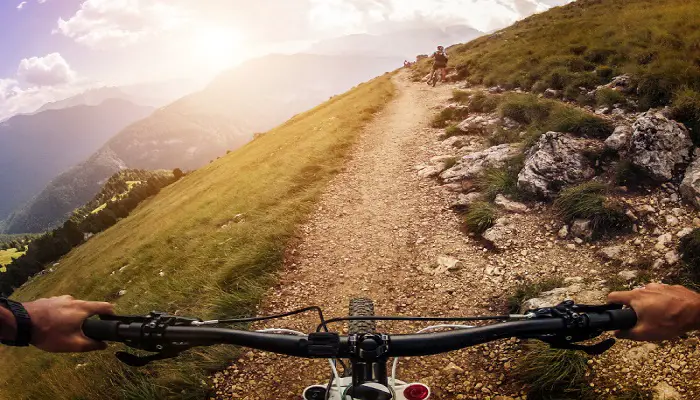Although the invention of the steam engine in the 18th century brought the Industrial Revolution, its use also increased pollution and exploitation of natural resources. Since then, the means to travel have changed to vehicles, planes, trains, and boats that use gasoline and diesel fuel, contributing to the alarming greenhouse effect even more.
Thankfully, the rise of sustainable tourism introduced a new type of tourist that cares for the environment and is willing to sacrifice commodities to preserve it. To become a part of this ever-growing trend, here are 12 ways you can turn into a mindful and responsible traveler.

1. Choose environmentally responsible airlines
When it comes to flying, you have two options that will keep your carbon footprint low: not to fly or choose environmentally responsible airlines. The latter use biofuel made from animal fats, cooking oil, crops, and unused wood. It’s estimated that 10% of fuel consumption will belong to biofuel by 2030.
If you can’t find an airline using biofuel, try booking a direct flight to spend less fuel. You can always opt for companies that offset CO2 emissions, meaning they install solar panels, plant trees, and do other activities to improve the environment.
2. Don’t print your tickets
Forget printing your tickets for flights, museums, exhibitions, theatres, and anything else you may need them for. Today, almost all vendors offer e-tickets to save paper and reduce the exploitation of trees. In case you do need to print something, make sure that you use recycled paper. Additionally, once you are done with your e-ticket, throw it into the recycle bin so it can be reused.

3. Bring a reusable water bottle with you
It may not be possible to always carry a reusable water bottle with you, but don’t miss the opportunity when you can. Almost 10 million tons of plastic bottles end up in the oceans, rivers, and other bodies of water every year. Based on estimates, the quantity of plastic will surpass the number of fish in the sea by 2050. Also, if you intend to spend time in nature, bring reusable utensils, plates, and other food containers to avoid leaving plastic waste behind you.
4. Pick up after yourself
Spending time in nature means that you have to be responsible and pick up your trash to dispose of it properly. Leftover food can attract animals, like bears, and lead to interactions with wildlife that will disrupt the ecosystem. Animals that are fed by humans are easy prey for poachers and tend to wander off into the settlements.

Litter can end up in waterways and harm aquatic fauna, as well or harm birds that swallow it. When you spend time in nature, keep in mind to leave nothing behind. Moreover, if you notice other people’s trash lying around, be kind and pick it up.
5. Use eco-friendly body products
Cosmetic products you use on your trip can also affect the environment. For example, sunscreen with oxybenzone can harm the ecosystem when you swim. Choose eco-friendly douches, soaps, and body lotions since they will end up in the drain when you shower and from there into the environment. It’s a good idea to always bring your green, vegan, and cruelty-free products with you since the hotel may offer a regular non-eco-friendly variety of toiletries.
6. Go to restaurants with sustainable food policies
It matters how a restaurant handles food and leftovers, as well as the energy to prepare meals. If you want to try local specialties, eat at restaurants that use local ingredients. With just a few taps on your phone, you can find out whether the restaurant donates leftovers and works on downsizing its carbon footprint.

Try vegetarian and vegan dishes made from seasonal products, and eat less meat which is responsible for almost 60% of greenhouse gasses created by food production. Organic food restaurants should also be an option for your meals, as well as those that use renewable energy sources.
7. Leave a car behind
Cars are serious contributors to greenhouse emissions which together with motorcycles and trucks live behind 1/5 of all carbon footprint. If you want to explore your destination, it’s better to avoid taxi, public transportation, and rent-a-car, and opt for walking or bikes.
When you travel to a national park, leave your car behind and ride mountain bikes. They are perfect for rough terrains and unpaved surfaces, but you can also use them on city streets. Moreover, if you travel locally, instead of going by car, hop on your bikes and turn it into a scenic adventure. It’s not only good for the environment but your body and mind as well.

8. Take a shower instead of bathing
Short showers will keep you equally clean as soaking in the bathtub for half an hour. The major difference is in the amount of water and energy you will spend in both situations. A quick shower will conserve water, but also it uses less electricity to heat that water.
For example, spending 10 minutes in the shower can use up to 18 gallons of water. To put it into perspective, one gallon equals eight 16-oz water bottles and a person should drink half a gallon a day. So, switch to 5-minute showers and turn off the water while you shampoo your hair and apply soap on the body.
9. Take unused hotel toiletries with you
In case you used hotel toiletries and didn’t spend it all, it’s best to take the rest with you. The hotel will throw them away and since they are made from plastic, they will end up polluting the environment. Besides the toiletries, you can also ask your hotel not to bring new towels, bathrobes, and linens every day. This will result in less laundry to wash, meaning the hotel will save on energy and water.
10. Buy locally-made products
Chances are that the local population sells souvenirs, clothes, accessories, and delicacies that it made. Choosing to buy these products you support their cultural heritage and small businesses, so all the money from tourism stays in the community.
Local markets are one of the best options to find everything in one place, but sometimes you can visit farms and estates as part of the tours. Furthermore, staying in a small family-owned hotel instead of a famous chain is another way to support sustainable tourism and the local economy.

11. Avoid activities endangering animal welfare
A lot of countries base their tourist attraction on animals, like riding a horse carriage or taking photos with an elephant. By participating in these activities you may be supporting animal abuse and mistreatment unintentionally.
National parks have nature reserves and rescue centers led by professionals who put animal welfare first. Sometimes, you are allowed to touch the animals, but in most cases, you can admire them from a distance, like a penguin colony in South Africa. If you care for animals, a donation is always welcome or volunteer work.
12. Travel more locally
To reduce carbon footprint, you can forget far away destinations and travel locally. Even if you go by car, it will contribute less to the CO2 emissions than traveling by plane. Of course, you can make this option more sustainable by carpooling, taking a bus, or riding on a train. Some local destinations are close enough to reach by bike or a few days of hiking and camping in nature.

In conclusion
Sustainable tourism is gaining momentum in the wake of increasing climate changes caused by global warming. Being mindful and responsible towards the environment when traveling can help to tackle the issue of our degrading environment. The travel industry has recognized this demand of travelers and places emphasis on local businesses, eco-friendly practices, and sustainable offers. More importantly, there are options for every budget, thus allowing tourists to actively participate in saving the planet.



